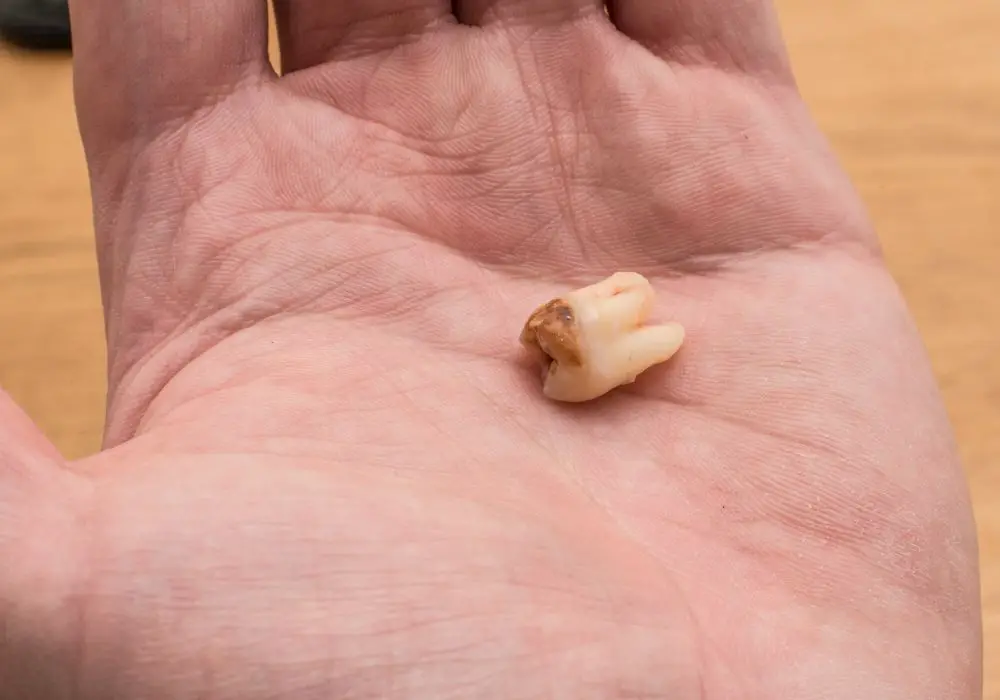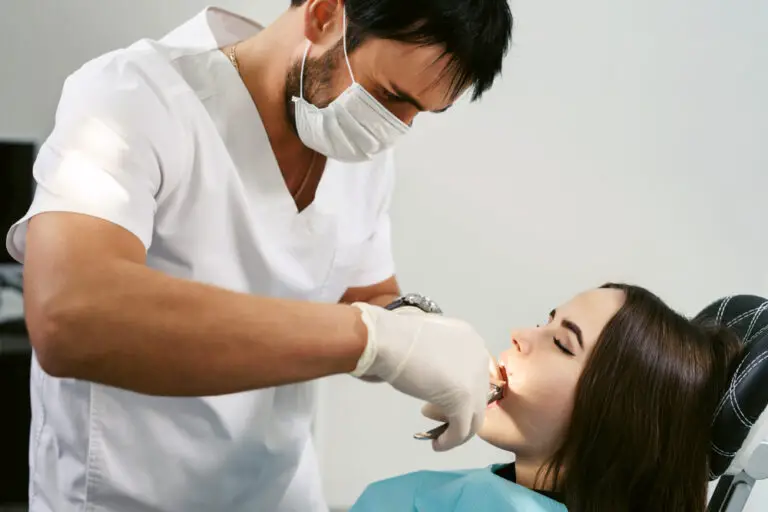Wisdom teeth are the third and final set of molars that emerge in most people between the late teens and early 20s. They are located in the very back of the mouth behind the second molars.
Wisdom teeth often become impacted or grow in improperly due to insufficient room in the jaw. The term “impacted” means the tooth becomes trapped under the gums and cannot fully emerge into the mouth. Impacted wisdom teeth may grow sideways, remain upside down, or become angled toward the second molars.
When wisdom teeth become impacted, it can lead to a number of problems such as:
- Pain – Partial eruption allows bacteria to enter around the tooth surfaces more easily, leading to infection and severe discomfort.
- Cysts or tumors – Non-erupted wisdom teeth may promote fluid-filled cysts or benign tumors that can expand and damage adjacent teeth and bone.
- Tooth decay – Improperly positioned wisdom teeth are harder to clean and prone to accelerated decay.
- Gum disease – The presence of wisdom teeth can make it easier for bacteria to accumulate and infect the gums.
- Tooth crowding or misalignment – Erupted wisdom teeth may begin to push against and shift nearby teeth, potentially undoing existing orthodontic work.
- Root resorption – Adjacent teeth roots may start to break down or dissolve due to pressure from impacted wisdom teeth.
- Jaw problems – Cysts and tumors related to impacted wisdom teeth can damage the jawbone and supporting tissues.
For these reasons, oral surgeons often recommend the early removal of wisdom teeth that are impacted or expected to emerge in misaligned positions. Extracting them between the late teens and early 20s prevents future problems when removal becomes more difficult.
Is it possible to remove wisdom teeth without surgery?
Less invasive wisdom tooth extraction without surgery may be possible in certain straightforward cases where the tooth:
- Is fully erupted through the gums with roots fully formed
- Has enough space in the dental arch
- Has an orientation that is easy to access
- Lacks signs of cysts, tumors, or infection
- Requires only a simple extraction without other procedures
The dentist can numb the area with local anesthesia and utilize dental extraction instruments like forceps to loosen and remove an erupted wisdom tooth that meets these criteria.
However, surgical extraction is required for impacted or partially erupted wisdom teeth. Attempting to simply pull out a tooth that is trapped under the gums and bone without surgical tools can fracture the tooth and leave root tips behind. Extensive manipulation also heightens the risk of complications like dry socket, nerve damage, and infection spread.
When is surgery necessary for wisdom tooth extraction?
More than 65% of wisdom teeth will not fully emerge or erupt properly, making surgical extraction necessary. Signs that surgical removal is needed include:
- Full impaction – The wisdom tooth remains unerupted under the gums and bone.
- Partial impaction – The wisdom tooth is only partially visible and has not fully emerged.
- Horizontal impaction – The wisdom tooth is growing sideways under or into the roots of the second molar.
- Unusual orientation – The wisdom tooth is tilted, angled forward or backward, or inverted.
- Multiple teeth – Extra wisdom teeth are present, such as five or six molars.
- Abnormal anatomy – The wisdom tooth has extra roots, hooked roots, or an abnormal shape.
- Periodontal disease – Gum disease or advanced decay makes the tooth unstable.
- Cysts or tumors – Cysts, benign growths, or other pathology are associated with the wisdom tooth.
- Pericoronitis – Infection and inflammation are present around the gums of a partially erupted tooth.
Surgical extraction creates an incision to provide access for removing impacted wisdom teeth properly. This prevents leaving portions of the tooth behind.
What are the risks of extracting wisdom teeth without surgery?
Attempting to extract impacted wisdom teeth without surgically entering the gums and bone comes with increased risks:
- Tooth fracture – Using excessive force on an unerupted tooth can cause the crown or roots to break. This leaves pieces behind and makes removal more difficult.
- Nerve injury – Manipulating impacted teeth roughly without surgical access can damage the lingual nerve and inferior alveolar nerve. This may cause numbness that lasts weeks or months.
- Damage to other teeth – Attempting to pull out impacted wisdom teeth can sometimes crack or loosen nearby teeth, especially the second molars.
- Displaced tooth fragments – Breaking an impacted wisdom tooth into pieces makes fragments more likely to be displaced into surrounding tissues.
- Infection – Non-surgical attempts at extraction when pericoronitis is already present can spread the infection deeper through tissues.
- Dry socket – Aggressive manipulation required for non-surgical extractions increases chances of dry socket, exposing bone and nerves.
- Bleeding – More forceful handling of soft tissues raises the risk of prolonged bleeding or hemorrhage.
- Need for second surgery – If surgical extraction is still needed after a failed first attempt, the procedure becomes more complicated due to added swelling, scarring, and infection risk.
These risks are why surgical extraction is recommended for impacted wisdom teeth removal in most cases. The surgical approach minimizes chances of complications.
What does wisdom tooth extraction surgery involve?

Surgical removal of impacted wisdom teeth is an outpatient procedure performed by an oral surgeon under local or general anesthesia. The steps include:
- Anesthesia – The patient receives either local anesthetic injections to numb the area or general anesthesia to be fully sedated.
- Incisions – The surgeon will make incisions in the gums overlying the impacted tooth to reveal the bone.
- Bone removal – Some bone may be removed around the crown with a drill or osteotome to expose the tooth for removal.
- Tooth sectioning – The tooth may be cut into smaller pieces with a drill to make extraction easier if severely impacted.
- Tooth removal – The surgeon utilizes elevators and forceps to fully extract the entire wisdom tooth, crown, and roots.
- Irrigation – The socket is flushed to remove debris. Suction is used to keep the area clear.
- Stitches – The gums are closed up with sutures that gradually dissolve over time as the site heals.
- Additional procedures – In some cases, excess bone or cysts may also need to be removed to fully extract the impacted tooth.
Proper surgical technique ensures the wisdom tooth can be removed in its entirety through the access of the incision.
What is the recovery like after wisdom tooth extraction surgery?
Recovering from wisdom tooth extraction surgery may take about 7-10 days. Typical postoperative care includes:
- Pain management – Use ice packs for the first few days to reduce swelling. Over-the-counter pain relievers can treat soreness and discomfort.
- Bleeding – Some minor bleeding is normal. Use gauze bites to help control bleeding on the day of surgery.
- Diet – Stick to soft foods like yogurt, applesauce, and soups as you heal. Avoid extremely hot or spicy foods.
- Oral hygiene – Resume gentle brushing about 24 hours later, but be gentle around the extraction sites at first.
- Activity – Rest for the first day or two. Then gradually increase activity over 7-10 days. Avoid vigorous exercise during the first week of recovery.
- Healing – Swelling may peak on the third day before slowly decreasing. Numbness from anesthetic can last several hours.
- Follow-up appointment – See your surgeon after about 1-2 weeks to evaluate your healing.
Call your oral surgeon if you experience severe pain, bleeding you cannot control, worsening swelling, or other issues.
When should you see a dentist after wisdom tooth removal?
 Make sure to follow up with your dentist or oral surgeon if you have any of the following longer-term issues:
Make sure to follow up with your dentist or oral surgeon if you have any of the following longer-term issues:
- Ongoing bleeding, swelling, or pus drainage after a week
- Severe throbbing pain that seems to worsen with time
- Numbness in your lip, chin, or tongue that persists longer than a few weeks
- Gum tissue around the extraction site appears white and feels tender
- Halitosis (bad breath) or foul taste coming from the socket
- Sores, chipped teeth, or other signs of trauma from the extraction
- Part of the wisdom tooth remains or was left behind
These symptoms may indicate complications like dry socket, infection, or nerve injury needing additional treatment. Otherwise, schedule a regular dental cleaning a few weeks after wisdom tooth removal once healing is complete.
Can wisdom teeth be left in?
Some third molars may properly emerge into the correct upright position and function normally like other teeth. In these cases, they may not necessarily need to be removed.
However, the majority of wisdom teeth develop in ways that lead to problems over time. Potential issues with leaving impacted wisdom teeth in place include:
- Progressive pain, cysts, gum disease, and decay as space tightens
- Loss of adjacent teeth from infection spread or root resorption
- Orthodontic relapse or crowding as wisdom teeth try to erupt
- Increasing difficulty of surgical removal as roots form and bone hardens
- Risk of pathology like tumors developing within impacted teeth
- Higher incidence of gum disease and dental problems with age
Dentists typically assess the position of emerging wisdom teeth during the late teens. Early removal is recommended for teeth expected to become problematic. Monitoring is an option for properly aligned wisdom teeth without impaction.
When should wisdom teeth be removed?
Ideally, wisdom teeth that require extraction should be removed between the ages of 17-25 before the roots are fully formed and the bone is less dense. Removal at a younger age leads to:
- Shorter, easier procedures
- Reduced risk of complications
- Faster healing
- Less postoperative pain and swelling
Beyond the mid-20s, removal becomes more difficult and the risks increase. Wisdom teeth may continue to erupt until around age 21, so ongoing monitoring from your dentist is important. They can help determine the best timing for extraction based on your specific teeth.
Are there alternatives to wisdom tooth extraction?

In some scenarios, the following may be alternatives to wisdom tooth removal for select patients:
- Periodic monitoring – If the wisdom teeth are well-aligned and positioned, your dentist may recommend periodic x-rays and exams rather than extraction.
- Tooth exposure – A minimally invasive gum surgery may be done to uncover an impacted wisdom tooth and allow it to continue erupting normally.
- Tooth alignment – Orthodontics may create room for partially impacted wisdom teeth to erupt by uprighting adjacent teeth.
- Coronectomy – The crown of the wisdom tooth is removed while the roots are left in place to reduce nerve damage risks.
- Root canal – If decay or damage affects only one wisdom tooth, a root canal may help save it.
- Tooth splinting – Stabilizing an erupted wisdom tooth to neighboring teeth may prevent impaction.
However, evidence on some of these techniques is limited, and extraction is still usually the best approach for problematic wisdom teeth. Non-extraction methods may not provide reliable long-term outcomes.
Frequently Asked Questions
Q: Can I pull out my own wisdom tooth?
A: No, you should never attempt to pull out your own wisdom tooth. Doing so can lead to severe infections, extensive damage, and serious complications. Always leave wisdom tooth extraction to an oral surgeon.
Q: How long does wisdom tooth surgery take?
A: Wisdom tooth surgery typically takes about 20-40 minutes per tooth depending on the impaction severity. Removing all four wisdom teeth in a single visit may take 1-2 hours.
Q: How painful is wisdom tooth surgery?
A: Having your wisdom teeth surgically removed does involve some degree of pain and discomfort after the anesthetic wears off. This can be managed with prescription pain medication and ice packs. Pain should steadily improve after the first 3 days.
Q: Can wisdom teeth shift other teeth as they emerge?
A: Yes, wisdom teeth that only partially erupt can sometimes apply pressure that slowly shifts adjacent teeth over time. This is why early extraction is often recommended.
Q: Can wisdom teeth grow back if they are removed?
A: No, wisdom teeth that are fully extracted do not grow back. However, sometimes root tips may be left in place intentionally to reduce nerve damage risks. But there will be no regrowth of the removed tooth portions.







